Strategic Human Resource Development and Toyota's Challenges
VerifiedAdded on 2023/06/15
|15
|2892
|126
Report
AI Summary
This report examines the human resource challenges faced by Toyota, focusing on the impact of these issues on the company's performance and reputation. It discusses the characteristics of adult learners in the context of Toyota's workforce and proposes strategies for an effective training program to address skill gaps and improve employee performance. The report also outlines methods for evaluating the success of the training initiatives, emphasizing the importance of alignment, pre-course briefings, and post-course debriefing. Key areas covered include the lack of technical skills, faulty reward systems, and corporate culture issues that contributed to Toyota's downfall. Ultimately, the report underscores the critical role of strategic human resource development in enhancing organizational performance and preventing future crises. The analysis provides insights into how Toyota can rebuild its HR practices to ensure quality and regain its competitive edge.
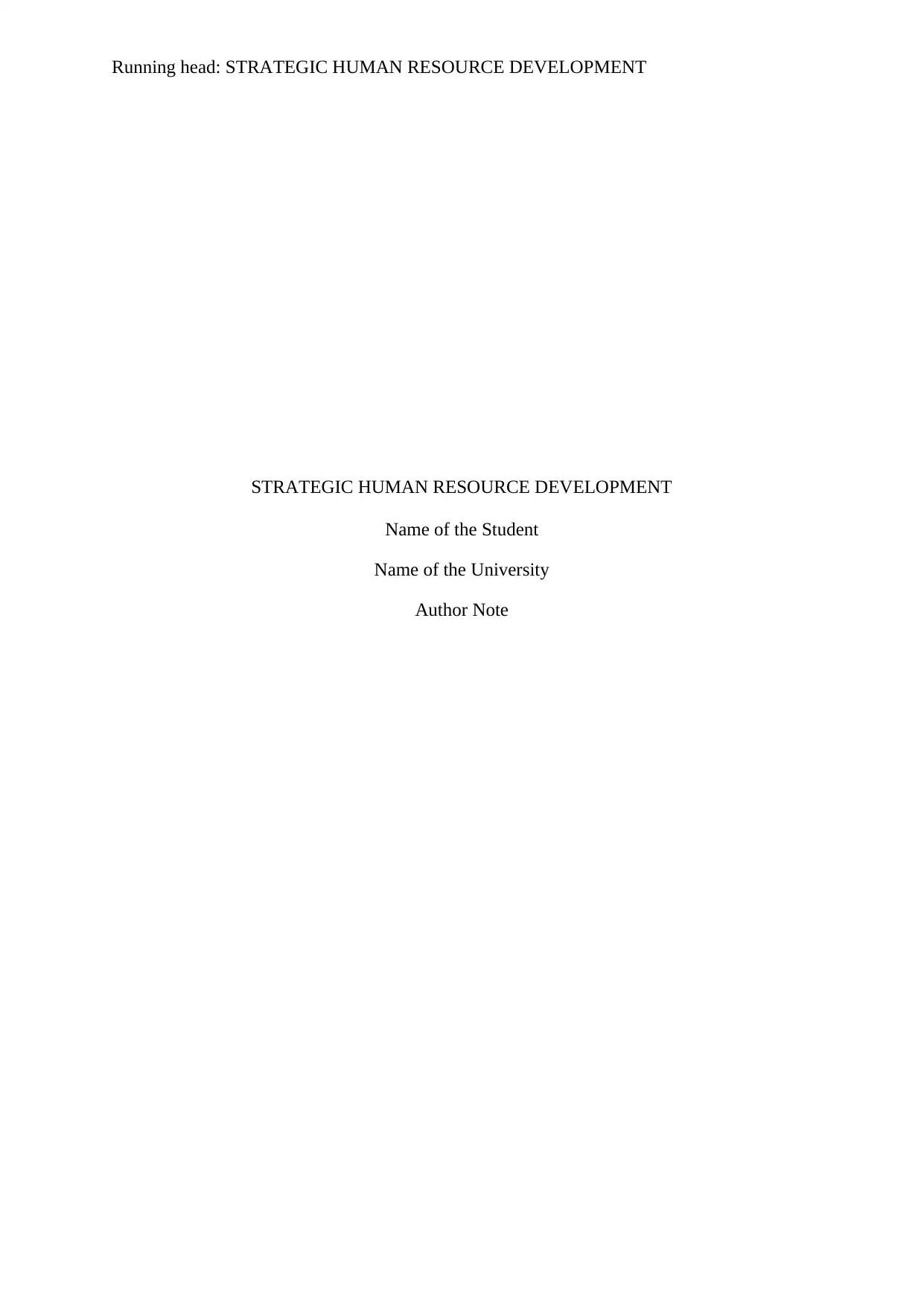
Running head: STRATEGIC HUMAN RESOURCE DEVELOPMENT
STRATEGIC HUMAN RESOURCE DEVELOPMENT
Name of the Student
Name of the University
Author Note
STRATEGIC HUMAN RESOURCE DEVELOPMENT
Name of the Student
Name of the University
Author Note
Paraphrase This Document
Need a fresh take? Get an instant paraphrase of this document with our AI Paraphraser
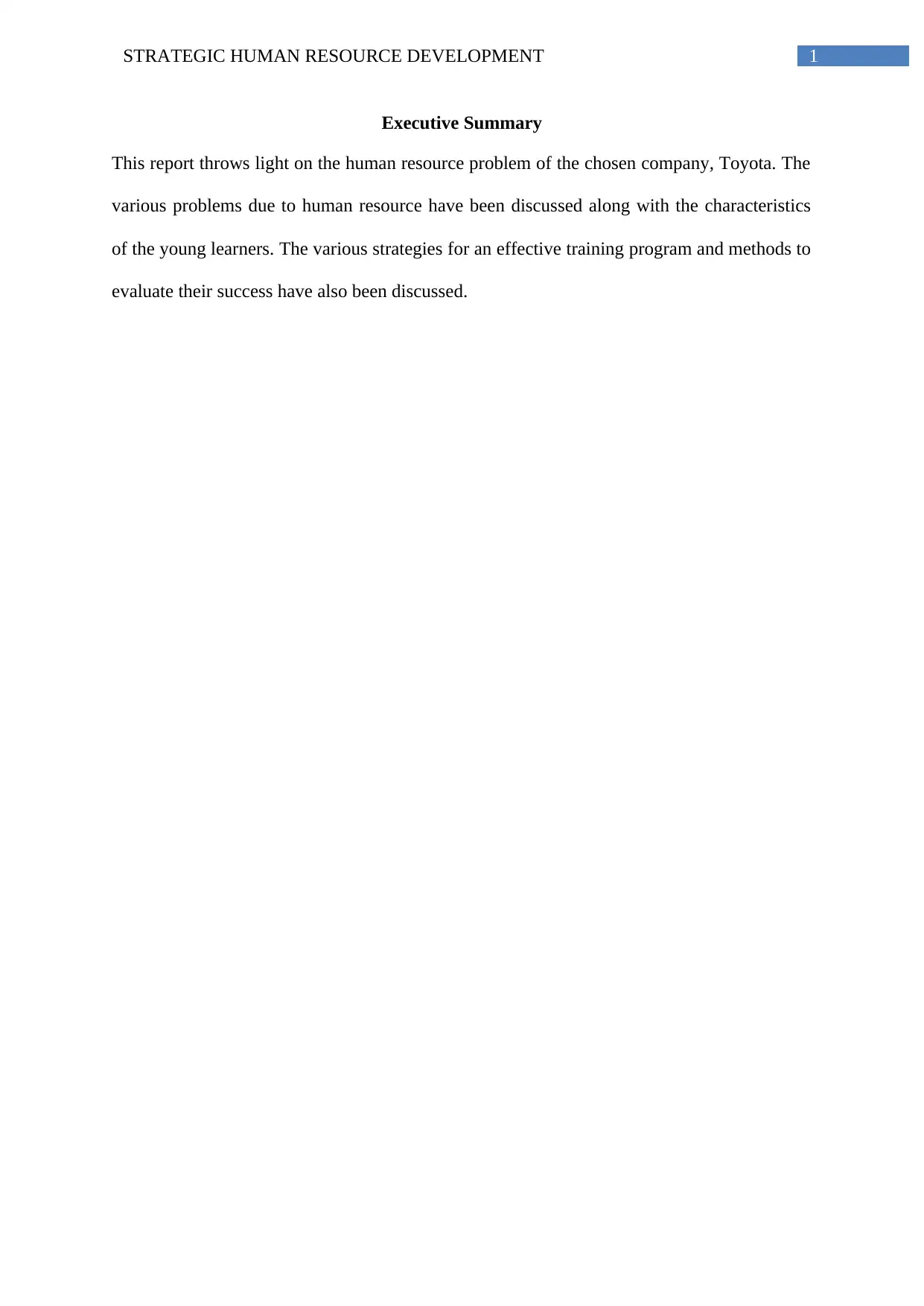
1STRATEGIC HUMAN RESOURCE DEVELOPMENT
Executive Summary
This report throws light on the human resource problem of the chosen company, Toyota. The
various problems due to human resource have been discussed along with the characteristics
of the young learners. The various strategies for an effective training program and methods to
evaluate their success have also been discussed.
Executive Summary
This report throws light on the human resource problem of the chosen company, Toyota. The
various problems due to human resource have been discussed along with the characteristics
of the young learners. The various strategies for an effective training program and methods to
evaluate their success have also been discussed.
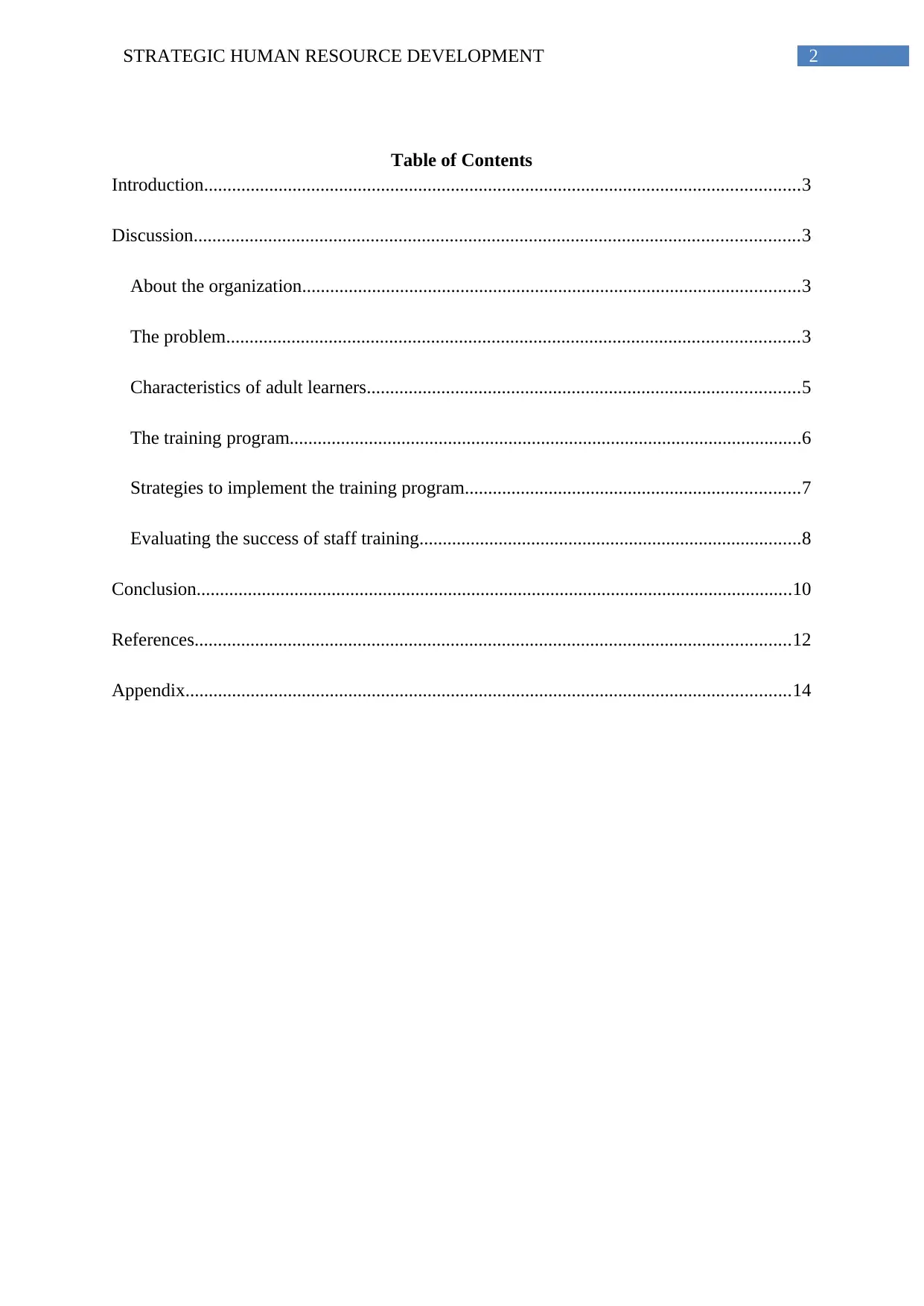
2STRATEGIC HUMAN RESOURCE DEVELOPMENT
Table of Contents
Introduction................................................................................................................................3
Discussion..................................................................................................................................3
About the organization...........................................................................................................3
The problem...........................................................................................................................3
Characteristics of adult learners.............................................................................................5
The training program..............................................................................................................6
Strategies to implement the training program........................................................................7
Evaluating the success of staff training..................................................................................8
Conclusion................................................................................................................................10
References................................................................................................................................12
Appendix..................................................................................................................................14
Table of Contents
Introduction................................................................................................................................3
Discussion..................................................................................................................................3
About the organization...........................................................................................................3
The problem...........................................................................................................................3
Characteristics of adult learners.............................................................................................5
The training program..............................................................................................................6
Strategies to implement the training program........................................................................7
Evaluating the success of staff training..................................................................................8
Conclusion................................................................................................................................10
References................................................................................................................................12
Appendix..................................................................................................................................14
⊘ This is a preview!⊘
Do you want full access?
Subscribe today to unlock all pages.

Trusted by 1+ million students worldwide
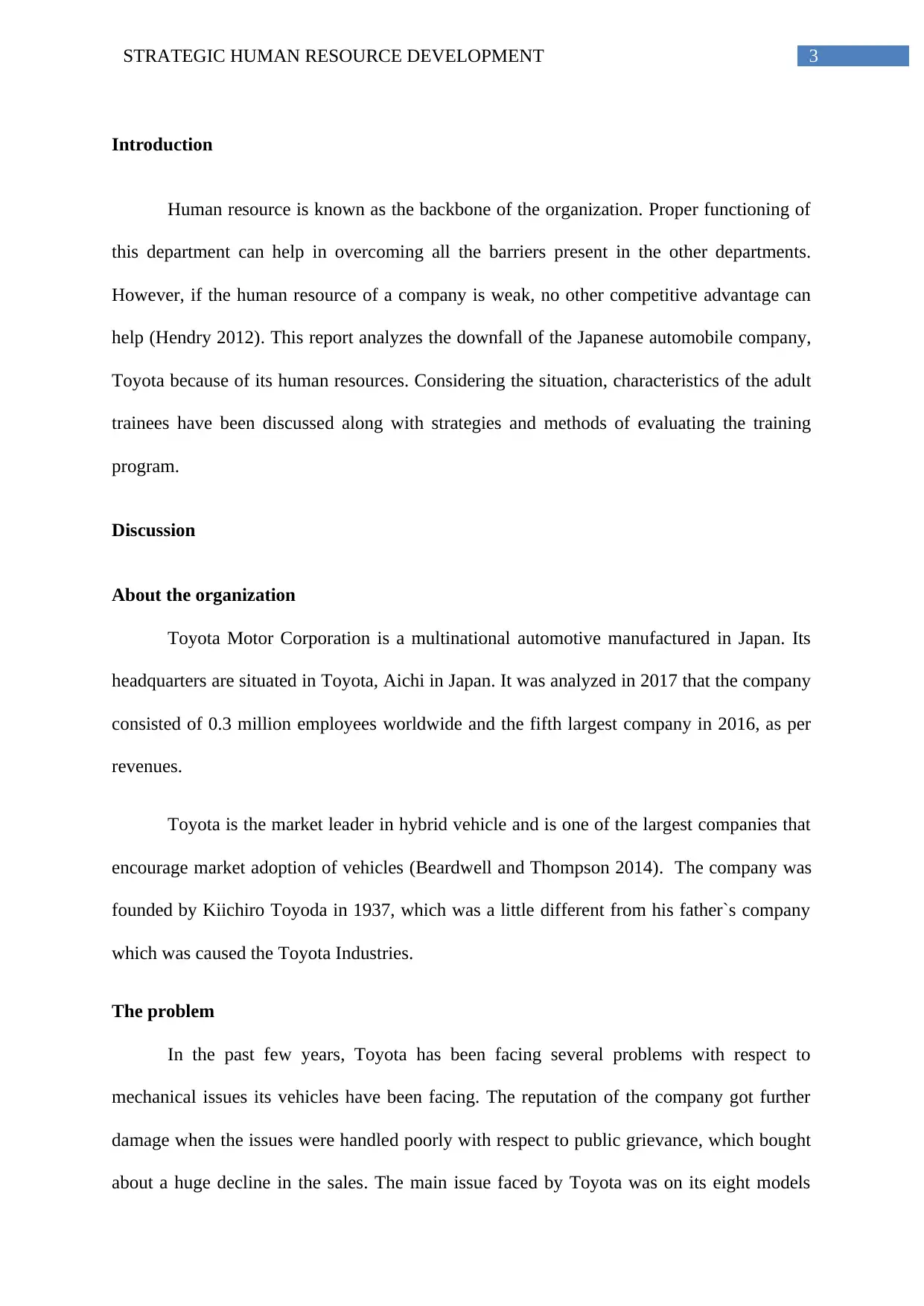
3STRATEGIC HUMAN RESOURCE DEVELOPMENT
Introduction
Human resource is known as the backbone of the organization. Proper functioning of
this department can help in overcoming all the barriers present in the other departments.
However, if the human resource of a company is weak, no other competitive advantage can
help (Hendry 2012). This report analyzes the downfall of the Japanese automobile company,
Toyota because of its human resources. Considering the situation, characteristics of the adult
trainees have been discussed along with strategies and methods of evaluating the training
program.
Discussion
About the organization
Toyota Motor Corporation is a multinational automotive manufactured in Japan. Its
headquarters are situated in Toyota, Aichi in Japan. It was analyzed in 2017 that the company
consisted of 0.3 million employees worldwide and the fifth largest company in 2016, as per
revenues.
Toyota is the market leader in hybrid vehicle and is one of the largest companies that
encourage market adoption of vehicles (Beardwell and Thompson 2014). The company was
founded by Kiichiro Toyoda in 1937, which was a little different from his father`s company
which was caused the Toyota Industries.
The problem
In the past few years, Toyota has been facing several problems with respect to
mechanical issues its vehicles have been facing. The reputation of the company got further
damage when the issues were handled poorly with respect to public grievance, which bought
about a huge decline in the sales. The main issue faced by Toyota was on its eight models
Introduction
Human resource is known as the backbone of the organization. Proper functioning of
this department can help in overcoming all the barriers present in the other departments.
However, if the human resource of a company is weak, no other competitive advantage can
help (Hendry 2012). This report analyzes the downfall of the Japanese automobile company,
Toyota because of its human resources. Considering the situation, characteristics of the adult
trainees have been discussed along with strategies and methods of evaluating the training
program.
Discussion
About the organization
Toyota Motor Corporation is a multinational automotive manufactured in Japan. Its
headquarters are situated in Toyota, Aichi in Japan. It was analyzed in 2017 that the company
consisted of 0.3 million employees worldwide and the fifth largest company in 2016, as per
revenues.
Toyota is the market leader in hybrid vehicle and is one of the largest companies that
encourage market adoption of vehicles (Beardwell and Thompson 2014). The company was
founded by Kiichiro Toyoda in 1937, which was a little different from his father`s company
which was caused the Toyota Industries.
The problem
In the past few years, Toyota has been facing several problems with respect to
mechanical issues its vehicles have been facing. The reputation of the company got further
damage when the issues were handled poorly with respect to public grievance, which bought
about a huge decline in the sales. The main issue faced by Toyota was on its eight models
Paraphrase This Document
Need a fresh take? Get an instant paraphrase of this document with our AI Paraphraser
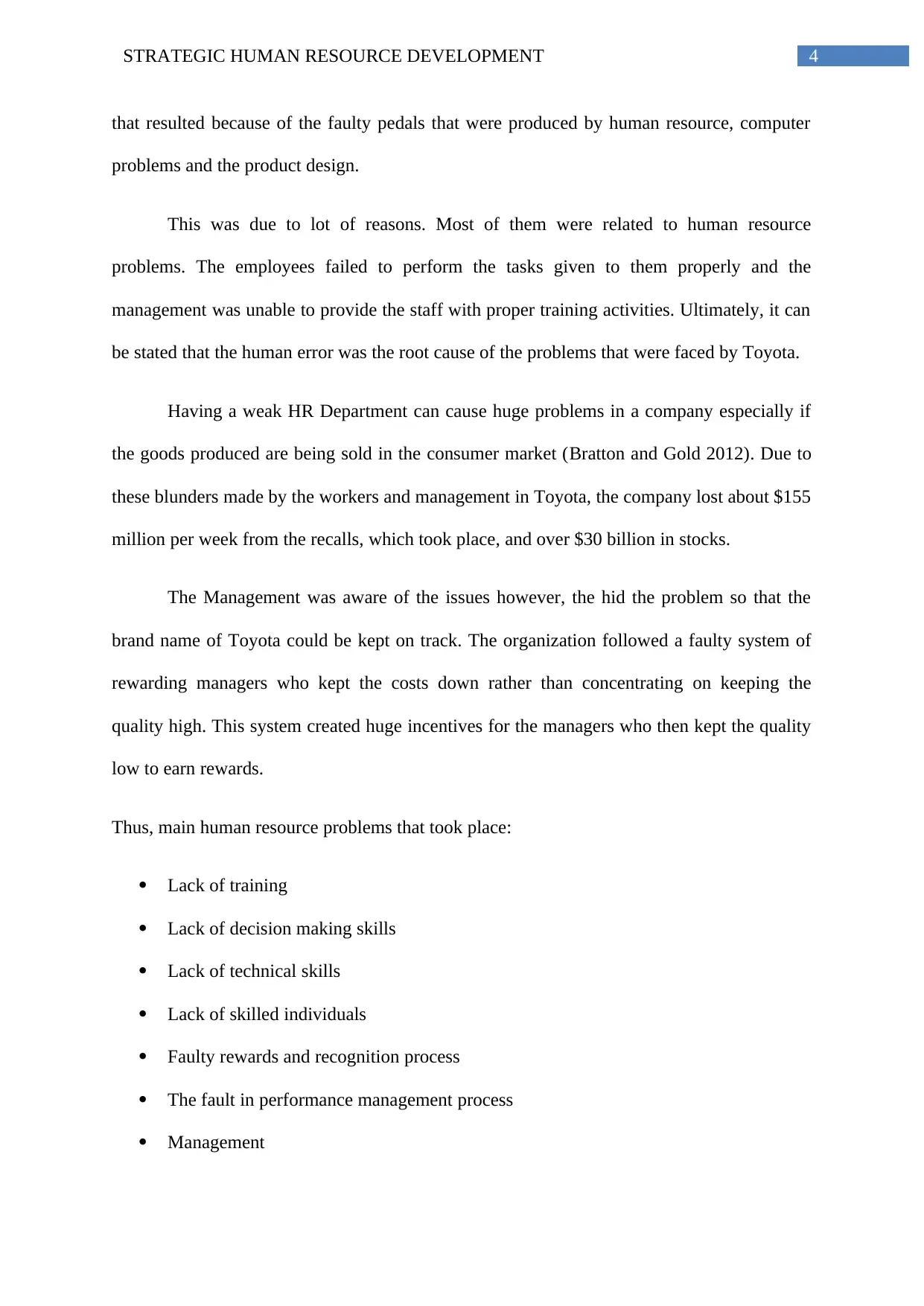
4STRATEGIC HUMAN RESOURCE DEVELOPMENT
that resulted because of the faulty pedals that were produced by human resource, computer
problems and the product design.
This was due to lot of reasons. Most of them were related to human resource
problems. The employees failed to perform the tasks given to them properly and the
management was unable to provide the staff with proper training activities. Ultimately, it can
be stated that the human error was the root cause of the problems that were faced by Toyota.
Having a weak HR Department can cause huge problems in a company especially if
the goods produced are being sold in the consumer market (Bratton and Gold 2012). Due to
these blunders made by the workers and management in Toyota, the company lost about $155
million per week from the recalls, which took place, and over $30 billion in stocks.
The Management was aware of the issues however, the hid the problem so that the
brand name of Toyota could be kept on track. The organization followed a faulty system of
rewarding managers who kept the costs down rather than concentrating on keeping the
quality high. This system created huge incentives for the managers who then kept the quality
low to earn rewards.
Thus, main human resource problems that took place:
Lack of training
Lack of decision making skills
Lack of technical skills
Lack of skilled individuals
Faulty rewards and recognition process
The fault in performance management process
Management
that resulted because of the faulty pedals that were produced by human resource, computer
problems and the product design.
This was due to lot of reasons. Most of them were related to human resource
problems. The employees failed to perform the tasks given to them properly and the
management was unable to provide the staff with proper training activities. Ultimately, it can
be stated that the human error was the root cause of the problems that were faced by Toyota.
Having a weak HR Department can cause huge problems in a company especially if
the goods produced are being sold in the consumer market (Bratton and Gold 2012). Due to
these blunders made by the workers and management in Toyota, the company lost about $155
million per week from the recalls, which took place, and over $30 billion in stocks.
The Management was aware of the issues however, the hid the problem so that the
brand name of Toyota could be kept on track. The organization followed a faulty system of
rewarding managers who kept the costs down rather than concentrating on keeping the
quality high. This system created huge incentives for the managers who then kept the quality
low to earn rewards.
Thus, main human resource problems that took place:
Lack of training
Lack of decision making skills
Lack of technical skills
Lack of skilled individuals
Faulty rewards and recognition process
The fault in performance management process
Management
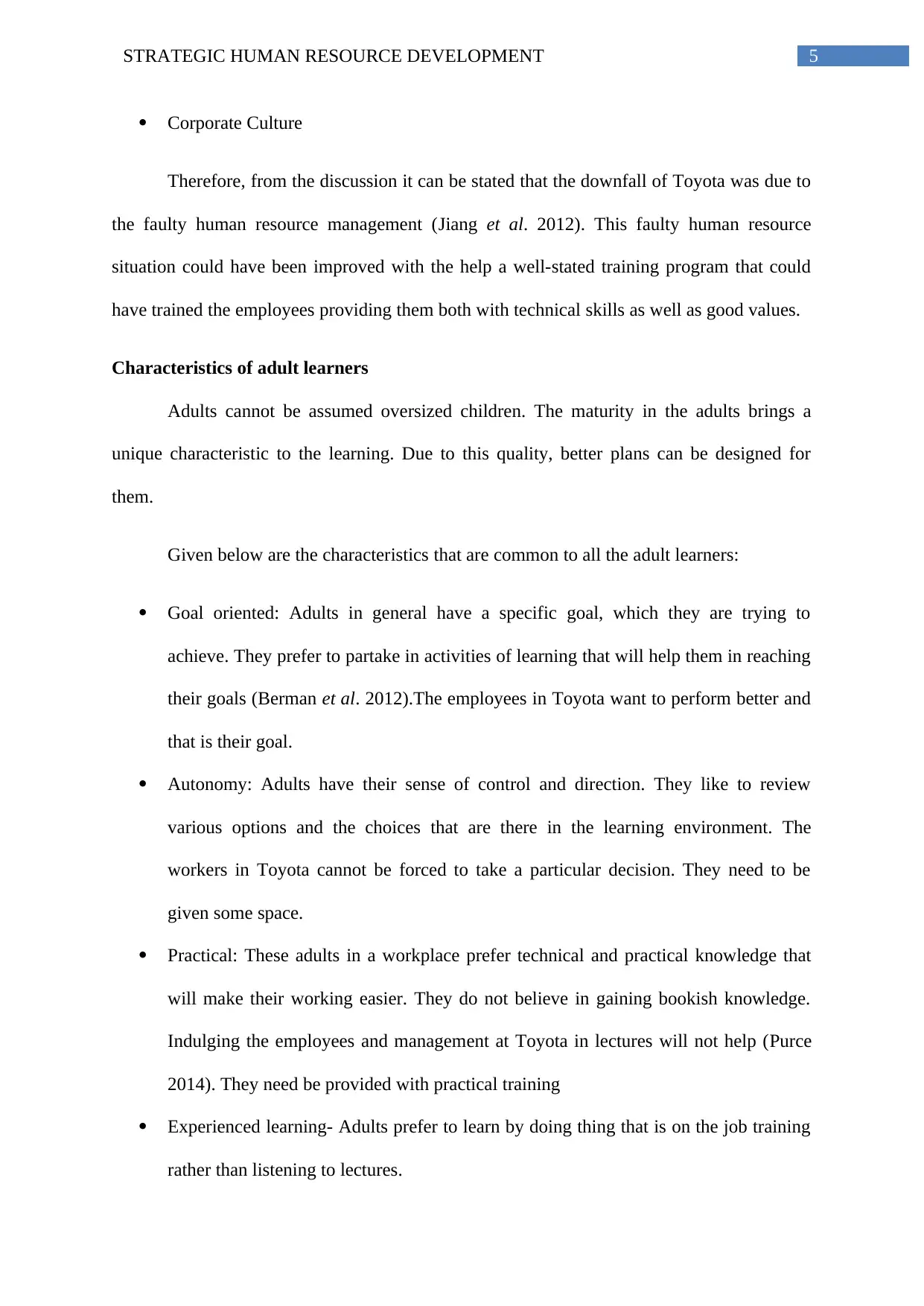
5STRATEGIC HUMAN RESOURCE DEVELOPMENT
Corporate Culture
Therefore, from the discussion it can be stated that the downfall of Toyota was due to
the faulty human resource management (Jiang et al. 2012). This faulty human resource
situation could have been improved with the help a well-stated training program that could
have trained the employees providing them both with technical skills as well as good values.
Characteristics of adult learners
Adults cannot be assumed oversized children. The maturity in the adults brings a
unique characteristic to the learning. Due to this quality, better plans can be designed for
them.
Given below are the characteristics that are common to all the adult learners:
Goal oriented: Adults in general have a specific goal, which they are trying to
achieve. They prefer to partake in activities of learning that will help them in reaching
their goals (Berman et al. 2012).The employees in Toyota want to perform better and
that is their goal.
Autonomy: Adults have their sense of control and direction. They like to review
various options and the choices that are there in the learning environment. The
workers in Toyota cannot be forced to take a particular decision. They need to be
given some space.
Practical: These adults in a workplace prefer technical and practical knowledge that
will make their working easier. They do not believe in gaining bookish knowledge.
Indulging the employees and management at Toyota in lectures will not help (Purce
2014). They need be provided with practical training
Experienced learning- Adults prefer to learn by doing thing that is on the job training
rather than listening to lectures.
Corporate Culture
Therefore, from the discussion it can be stated that the downfall of Toyota was due to
the faulty human resource management (Jiang et al. 2012). This faulty human resource
situation could have been improved with the help a well-stated training program that could
have trained the employees providing them both with technical skills as well as good values.
Characteristics of adult learners
Adults cannot be assumed oversized children. The maturity in the adults brings a
unique characteristic to the learning. Due to this quality, better plans can be designed for
them.
Given below are the characteristics that are common to all the adult learners:
Goal oriented: Adults in general have a specific goal, which they are trying to
achieve. They prefer to partake in activities of learning that will help them in reaching
their goals (Berman et al. 2012).The employees in Toyota want to perform better and
that is their goal.
Autonomy: Adults have their sense of control and direction. They like to review
various options and the choices that are there in the learning environment. The
workers in Toyota cannot be forced to take a particular decision. They need to be
given some space.
Practical: These adults in a workplace prefer technical and practical knowledge that
will make their working easier. They do not believe in gaining bookish knowledge.
Indulging the employees and management at Toyota in lectures will not help (Purce
2014). They need be provided with practical training
Experienced learning- Adults prefer to learn by doing thing that is on the job training
rather than listening to lectures.
⊘ This is a preview!⊘
Do you want full access?
Subscribe today to unlock all pages.

Trusted by 1+ million students worldwide
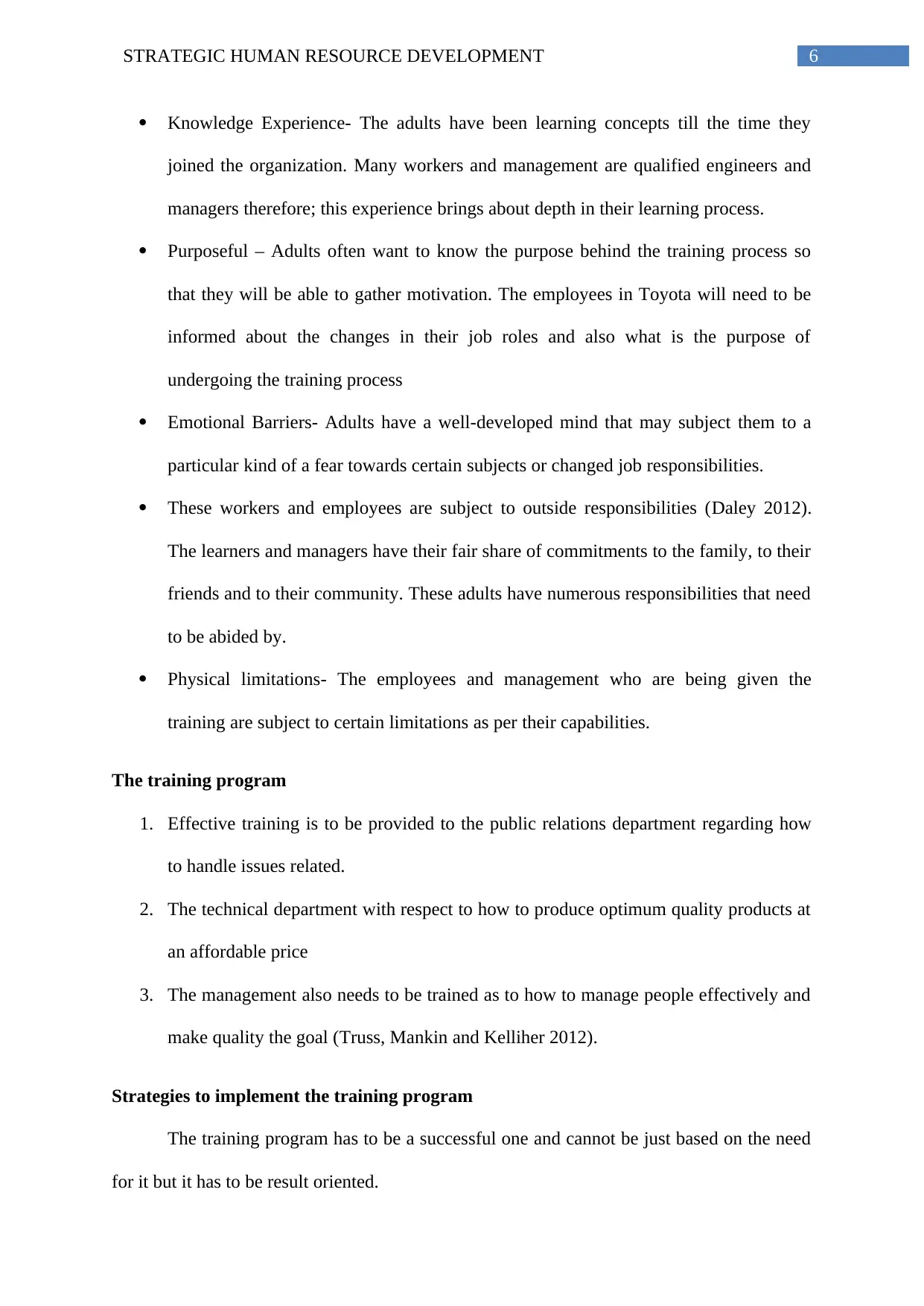
6STRATEGIC HUMAN RESOURCE DEVELOPMENT
Knowledge Experience- The adults have been learning concepts till the time they
joined the organization. Many workers and management are qualified engineers and
managers therefore; this experience brings about depth in their learning process.
Purposeful – Adults often want to know the purpose behind the training process so
that they will be able to gather motivation. The employees in Toyota will need to be
informed about the changes in their job roles and also what is the purpose of
undergoing the training process
Emotional Barriers- Adults have a well-developed mind that may subject them to a
particular kind of a fear towards certain subjects or changed job responsibilities.
These workers and employees are subject to outside responsibilities (Daley 2012).
The learners and managers have their fair share of commitments to the family, to their
friends and to their community. These adults have numerous responsibilities that need
to be abided by.
Physical limitations- The employees and management who are being given the
training are subject to certain limitations as per their capabilities.
The training program
1. Effective training is to be provided to the public relations department regarding how
to handle issues related.
2. The technical department with respect to how to produce optimum quality products at
an affordable price
3. The management also needs to be trained as to how to manage people effectively and
make quality the goal (Truss, Mankin and Kelliher 2012).
Strategies to implement the training program
The training program has to be a successful one and cannot be just based on the need
for it but it has to be result oriented.
Knowledge Experience- The adults have been learning concepts till the time they
joined the organization. Many workers and management are qualified engineers and
managers therefore; this experience brings about depth in their learning process.
Purposeful – Adults often want to know the purpose behind the training process so
that they will be able to gather motivation. The employees in Toyota will need to be
informed about the changes in their job roles and also what is the purpose of
undergoing the training process
Emotional Barriers- Adults have a well-developed mind that may subject them to a
particular kind of a fear towards certain subjects or changed job responsibilities.
These workers and employees are subject to outside responsibilities (Daley 2012).
The learners and managers have their fair share of commitments to the family, to their
friends and to their community. These adults have numerous responsibilities that need
to be abided by.
Physical limitations- The employees and management who are being given the
training are subject to certain limitations as per their capabilities.
The training program
1. Effective training is to be provided to the public relations department regarding how
to handle issues related.
2. The technical department with respect to how to produce optimum quality products at
an affordable price
3. The management also needs to be trained as to how to manage people effectively and
make quality the goal (Truss, Mankin and Kelliher 2012).
Strategies to implement the training program
The training program has to be a successful one and cannot be just based on the need
for it but it has to be result oriented.
Paraphrase This Document
Need a fresh take? Get an instant paraphrase of this document with our AI Paraphraser
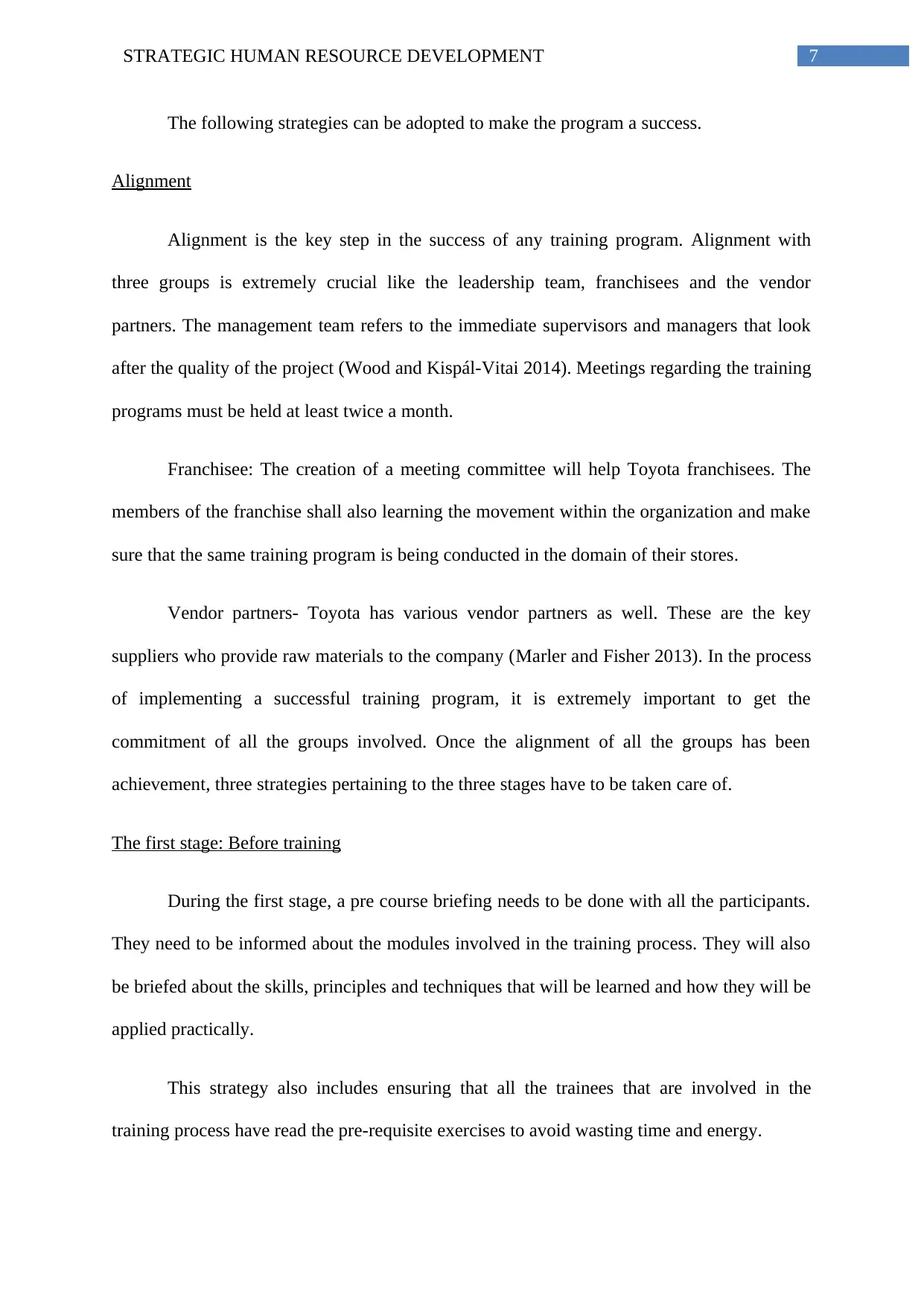
7STRATEGIC HUMAN RESOURCE DEVELOPMENT
The following strategies can be adopted to make the program a success.
Alignment
Alignment is the key step in the success of any training program. Alignment with
three groups is extremely crucial like the leadership team, franchisees and the vendor
partners. The management team refers to the immediate supervisors and managers that look
after the quality of the project (Wood and Kispál-Vitai 2014). Meetings regarding the training
programs must be held at least twice a month.
Franchisee: The creation of a meeting committee will help Toyota franchisees. The
members of the franchise shall also learning the movement within the organization and make
sure that the same training program is being conducted in the domain of their stores.
Vendor partners- Toyota has various vendor partners as well. These are the key
suppliers who provide raw materials to the company (Marler and Fisher 2013). In the process
of implementing a successful training program, it is extremely important to get the
commitment of all the groups involved. Once the alignment of all the groups has been
achievement, three strategies pertaining to the three stages have to be taken care of.
The first stage: Before training
During the first stage, a pre course briefing needs to be done with all the participants.
They need to be informed about the modules involved in the training process. They will also
be briefed about the skills, principles and techniques that will be learned and how they will be
applied practically.
This strategy also includes ensuring that all the trainees that are involved in the
training process have read the pre-requisite exercises to avoid wasting time and energy.
The following strategies can be adopted to make the program a success.
Alignment
Alignment is the key step in the success of any training program. Alignment with
three groups is extremely crucial like the leadership team, franchisees and the vendor
partners. The management team refers to the immediate supervisors and managers that look
after the quality of the project (Wood and Kispál-Vitai 2014). Meetings regarding the training
programs must be held at least twice a month.
Franchisee: The creation of a meeting committee will help Toyota franchisees. The
members of the franchise shall also learning the movement within the organization and make
sure that the same training program is being conducted in the domain of their stores.
Vendor partners- Toyota has various vendor partners as well. These are the key
suppliers who provide raw materials to the company (Marler and Fisher 2013). In the process
of implementing a successful training program, it is extremely important to get the
commitment of all the groups involved. Once the alignment of all the groups has been
achievement, three strategies pertaining to the three stages have to be taken care of.
The first stage: Before training
During the first stage, a pre course briefing needs to be done with all the participants.
They need to be informed about the modules involved in the training process. They will also
be briefed about the skills, principles and techniques that will be learned and how they will be
applied practically.
This strategy also includes ensuring that all the trainees that are involved in the
training process have read the pre-requisite exercises to avoid wasting time and energy.
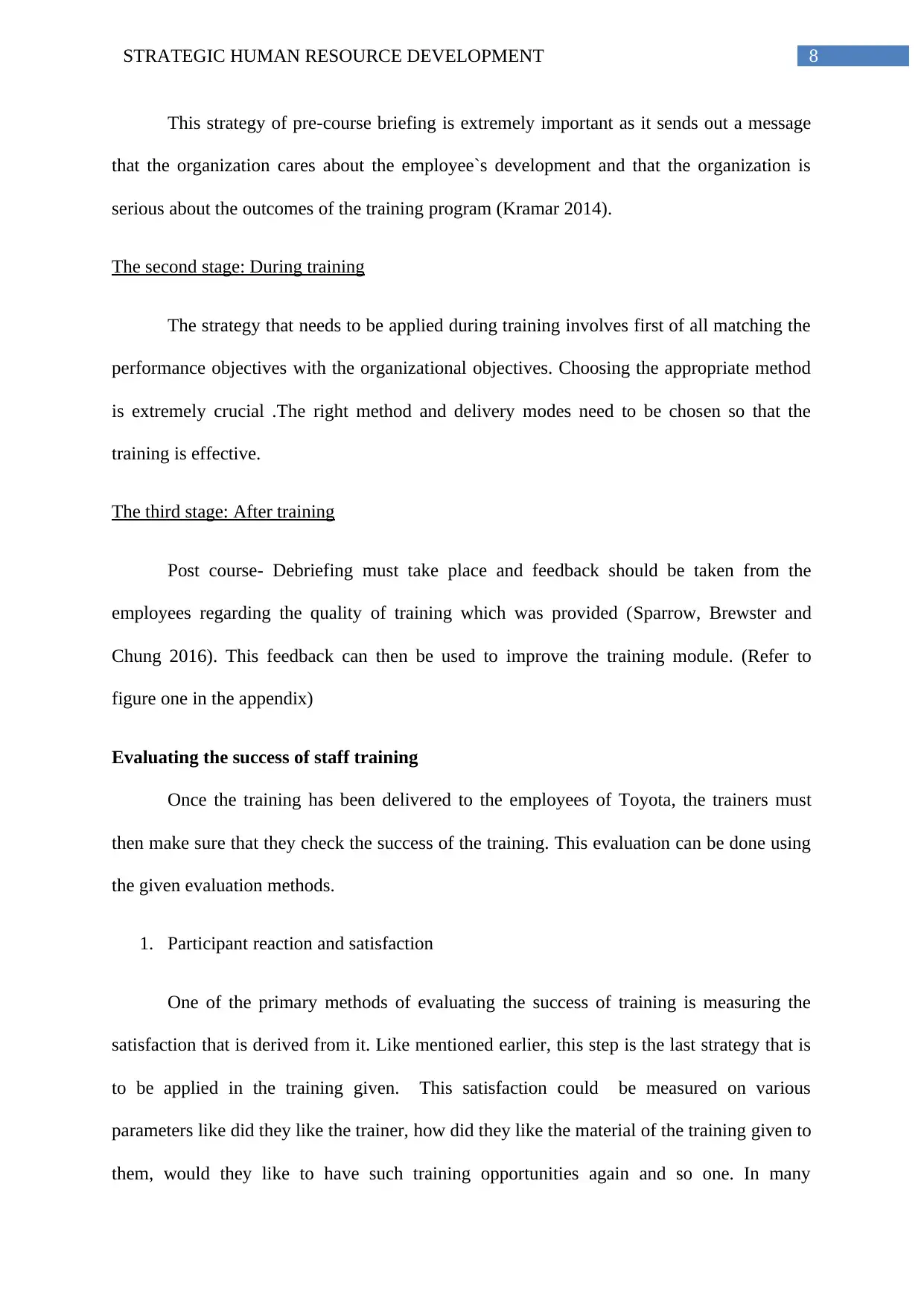
8STRATEGIC HUMAN RESOURCE DEVELOPMENT
This strategy of pre-course briefing is extremely important as it sends out a message
that the organization cares about the employee`s development and that the organization is
serious about the outcomes of the training program (Kramar 2014).
The second stage: During training
The strategy that needs to be applied during training involves first of all matching the
performance objectives with the organizational objectives. Choosing the appropriate method
is extremely crucial .The right method and delivery modes need to be chosen so that the
training is effective.
The third stage: After training
Post course- Debriefing must take place and feedback should be taken from the
employees regarding the quality of training which was provided (Sparrow, Brewster and
Chung 2016). This feedback can then be used to improve the training module. (Refer to
figure one in the appendix)
Evaluating the success of staff training
Once the training has been delivered to the employees of Toyota, the trainers must
then make sure that they check the success of the training. This evaluation can be done using
the given evaluation methods.
1. Participant reaction and satisfaction
One of the primary methods of evaluating the success of training is measuring the
satisfaction that is derived from it. Like mentioned earlier, this step is the last strategy that is
to be applied in the training given. This satisfaction could be measured on various
parameters like did they like the trainer, how did they like the material of the training given to
them, would they like to have such training opportunities again and so one. In many
This strategy of pre-course briefing is extremely important as it sends out a message
that the organization cares about the employee`s development and that the organization is
serious about the outcomes of the training program (Kramar 2014).
The second stage: During training
The strategy that needs to be applied during training involves first of all matching the
performance objectives with the organizational objectives. Choosing the appropriate method
is extremely crucial .The right method and delivery modes need to be chosen so that the
training is effective.
The third stage: After training
Post course- Debriefing must take place and feedback should be taken from the
employees regarding the quality of training which was provided (Sparrow, Brewster and
Chung 2016). This feedback can then be used to improve the training module. (Refer to
figure one in the appendix)
Evaluating the success of staff training
Once the training has been delivered to the employees of Toyota, the trainers must
then make sure that they check the success of the training. This evaluation can be done using
the given evaluation methods.
1. Participant reaction and satisfaction
One of the primary methods of evaluating the success of training is measuring the
satisfaction that is derived from it. Like mentioned earlier, this step is the last strategy that is
to be applied in the training given. This satisfaction could be measured on various
parameters like did they like the trainer, how did they like the material of the training given to
them, would they like to have such training opportunities again and so one. In many
⊘ This is a preview!⊘
Do you want full access?
Subscribe today to unlock all pages.

Trusted by 1+ million students worldwide
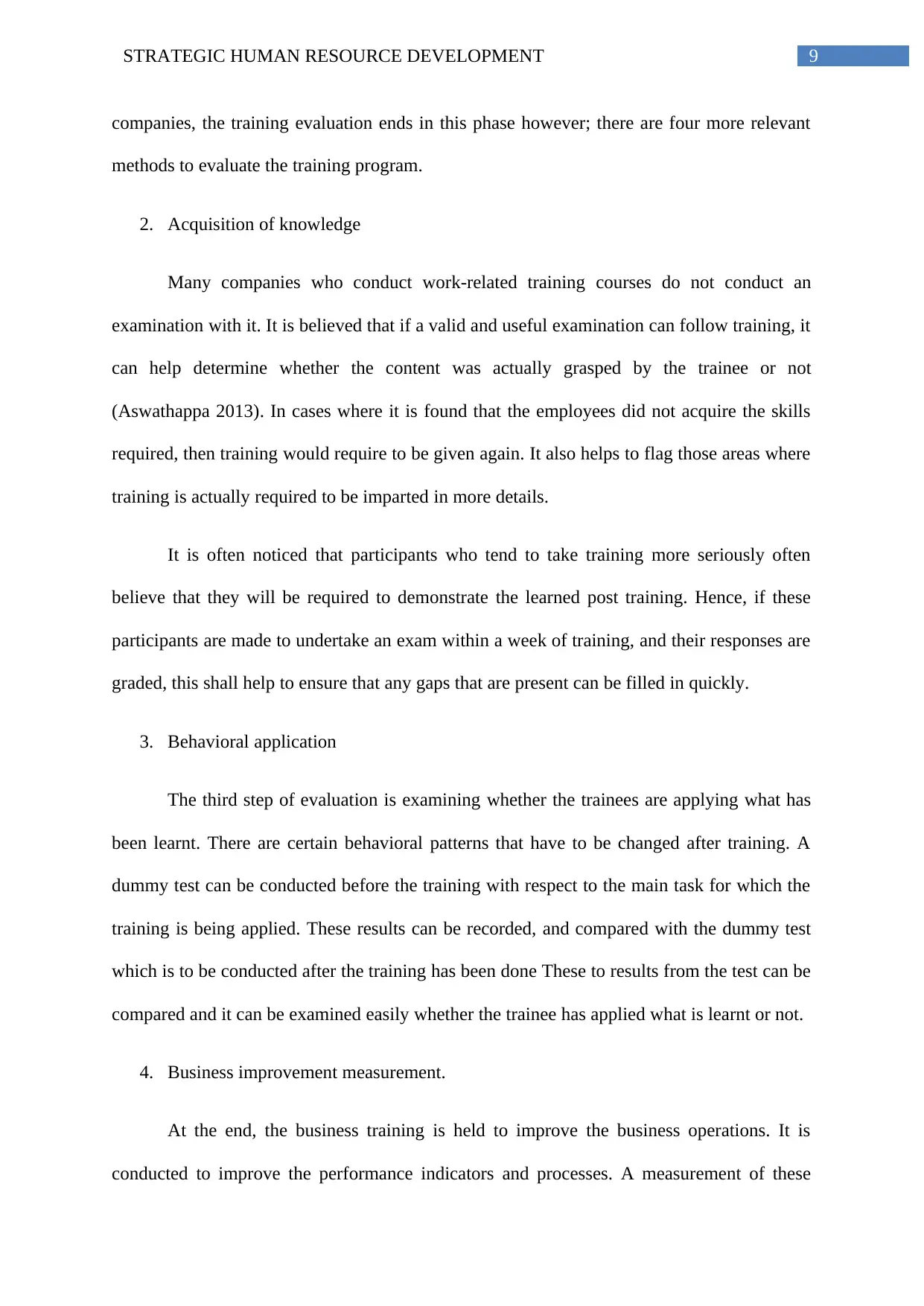
9STRATEGIC HUMAN RESOURCE DEVELOPMENT
companies, the training evaluation ends in this phase however; there are four more relevant
methods to evaluate the training program.
2. Acquisition of knowledge
Many companies who conduct work-related training courses do not conduct an
examination with it. It is believed that if a valid and useful examination can follow training, it
can help determine whether the content was actually grasped by the trainee or not
(Aswathappa 2013). In cases where it is found that the employees did not acquire the skills
required, then training would require to be given again. It also helps to flag those areas where
training is actually required to be imparted in more details.
It is often noticed that participants who tend to take training more seriously often
believe that they will be required to demonstrate the learned post training. Hence, if these
participants are made to undertake an exam within a week of training, and their responses are
graded, this shall help to ensure that any gaps that are present can be filled in quickly.
3. Behavioral application
The third step of evaluation is examining whether the trainees are applying what has
been learnt. There are certain behavioral patterns that have to be changed after training. A
dummy test can be conducted before the training with respect to the main task for which the
training is being applied. These results can be recorded, and compared with the dummy test
which is to be conducted after the training has been done These to results from the test can be
compared and it can be examined easily whether the trainee has applied what is learnt or not.
4. Business improvement measurement.
At the end, the business training is held to improve the business operations. It is
conducted to improve the performance indicators and processes. A measurement of these
companies, the training evaluation ends in this phase however; there are four more relevant
methods to evaluate the training program.
2. Acquisition of knowledge
Many companies who conduct work-related training courses do not conduct an
examination with it. It is believed that if a valid and useful examination can follow training, it
can help determine whether the content was actually grasped by the trainee or not
(Aswathappa 2013). In cases where it is found that the employees did not acquire the skills
required, then training would require to be given again. It also helps to flag those areas where
training is actually required to be imparted in more details.
It is often noticed that participants who tend to take training more seriously often
believe that they will be required to demonstrate the learned post training. Hence, if these
participants are made to undertake an exam within a week of training, and their responses are
graded, this shall help to ensure that any gaps that are present can be filled in quickly.
3. Behavioral application
The third step of evaluation is examining whether the trainees are applying what has
been learnt. There are certain behavioral patterns that have to be changed after training. A
dummy test can be conducted before the training with respect to the main task for which the
training is being applied. These results can be recorded, and compared with the dummy test
which is to be conducted after the training has been done These to results from the test can be
compared and it can be examined easily whether the trainee has applied what is learnt or not.
4. Business improvement measurement.
At the end, the business training is held to improve the business operations. It is
conducted to improve the performance indicators and processes. A measurement of these
Paraphrase This Document
Need a fresh take? Get an instant paraphrase of this document with our AI Paraphraser
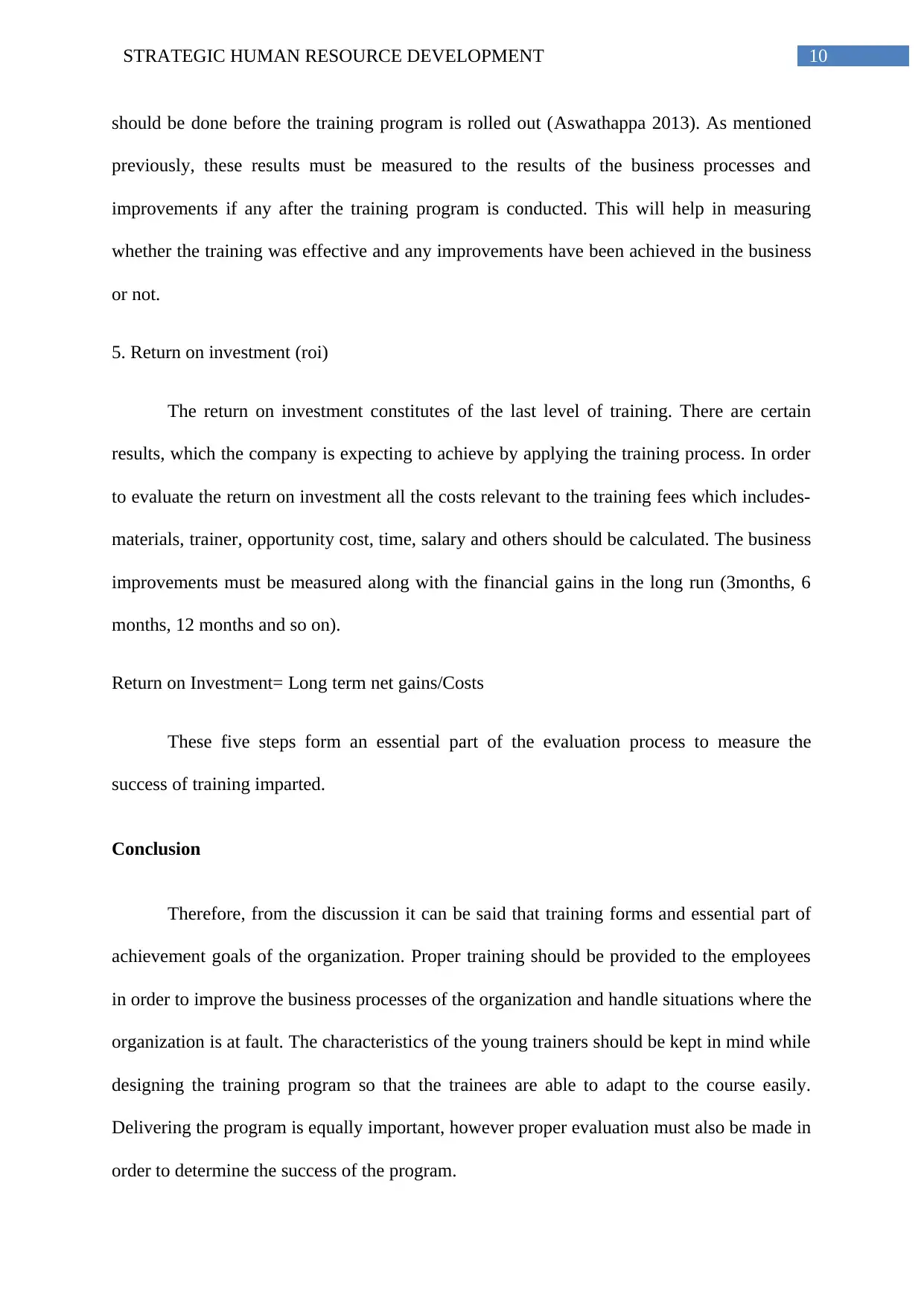
10STRATEGIC HUMAN RESOURCE DEVELOPMENT
should be done before the training program is rolled out (Aswathappa 2013). As mentioned
previously, these results must be measured to the results of the business processes and
improvements if any after the training program is conducted. This will help in measuring
whether the training was effective and any improvements have been achieved in the business
or not.
5. Return on investment (roi)
The return on investment constitutes of the last level of training. There are certain
results, which the company is expecting to achieve by applying the training process. In order
to evaluate the return on investment all the costs relevant to the training fees which includes-
materials, trainer, opportunity cost, time, salary and others should be calculated. The business
improvements must be measured along with the financial gains in the long run (3months, 6
months, 12 months and so on).
Return on Investment= Long term net gains/Costs
These five steps form an essential part of the evaluation process to measure the
success of training imparted.
Conclusion
Therefore, from the discussion it can be said that training forms and essential part of
achievement goals of the organization. Proper training should be provided to the employees
in order to improve the business processes of the organization and handle situations where the
organization is at fault. The characteristics of the young trainers should be kept in mind while
designing the training program so that the trainees are able to adapt to the course easily.
Delivering the program is equally important, however proper evaluation must also be made in
order to determine the success of the program.
should be done before the training program is rolled out (Aswathappa 2013). As mentioned
previously, these results must be measured to the results of the business processes and
improvements if any after the training program is conducted. This will help in measuring
whether the training was effective and any improvements have been achieved in the business
or not.
5. Return on investment (roi)
The return on investment constitutes of the last level of training. There are certain
results, which the company is expecting to achieve by applying the training process. In order
to evaluate the return on investment all the costs relevant to the training fees which includes-
materials, trainer, opportunity cost, time, salary and others should be calculated. The business
improvements must be measured along with the financial gains in the long run (3months, 6
months, 12 months and so on).
Return on Investment= Long term net gains/Costs
These five steps form an essential part of the evaluation process to measure the
success of training imparted.
Conclusion
Therefore, from the discussion it can be said that training forms and essential part of
achievement goals of the organization. Proper training should be provided to the employees
in order to improve the business processes of the organization and handle situations where the
organization is at fault. The characteristics of the young trainers should be kept in mind while
designing the training program so that the trainees are able to adapt to the course easily.
Delivering the program is equally important, however proper evaluation must also be made in
order to determine the success of the program.
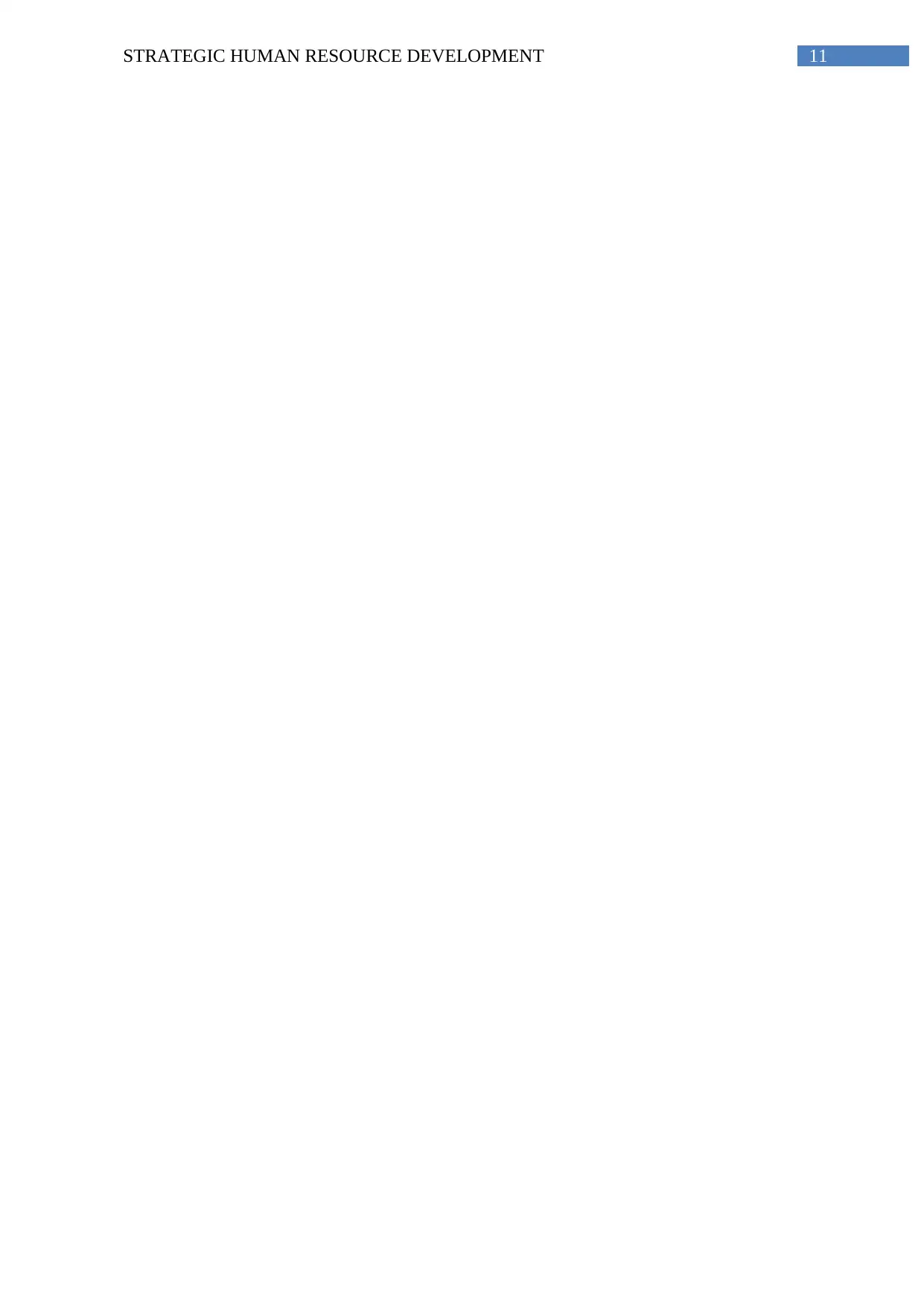
11STRATEGIC HUMAN RESOURCE DEVELOPMENT
⊘ This is a preview!⊘
Do you want full access?
Subscribe today to unlock all pages.

Trusted by 1+ million students worldwide
1 out of 15
Related Documents
Your All-in-One AI-Powered Toolkit for Academic Success.
+13062052269
info@desklib.com
Available 24*7 on WhatsApp / Email
![[object Object]](/_next/static/media/star-bottom.7253800d.svg)
Unlock your academic potential
Copyright © 2020–2025 A2Z Services. All Rights Reserved. Developed and managed by ZUCOL.





